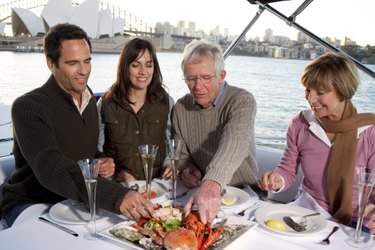
Stone crabs are one of the ocean's creatures sought after for their good taste, especially their claws. In fact, the sheer strength of a stone crab claw is powerful enough to break the shells of other, more resilient ocean crustaceans such as oysters. Because stone crabs are abundant, particularly in Florida, anyone with a crab trap can set out to harvest some stone crabs to eat.
What is a Stone Crab?
Video of the Day
A Stone Crab (Menippe mercenaria) is a subset species of a crab that lives, thrives and dwells in the ocean. Stone crabs crawl along the floor of the ocean, mainly sticking to shallow areas, as they forage for food along the bumpy sea floor. An adult stone crab can grow to a length of 5 to 6 inches and 5 inches in width. Distinguishable markings on the crab help set it apart from other crustaceans. Generally stone crabs are a reddish brown color all over with red spots or splotches dotting the top portion of the body. The underbelly of a stone crab is light brown or beige.
Video of the Day
Where are Stone Crabs Found?
Because the majority of stone crabs are found throughout Florida, they are oftentimes referred to as Florida stone crabs, though they can be found as far north as New England and as far south as Belize. Stone crabs are also common in the Gulf of Mexico and live in the waters in both Texas and Florida. Stone crabs have also been found in the warm water of the Caribbean, close to the Bahamas.
Catching Stone Crabs
The easiest place to find stone crabs is along shallow, rocky areas along the coast of Florida. By searching around and setting traps close to jetties, tidal pools, rocky areas and shallow tide areas, you will have a better success rate in catching stone crabs. Assess a stone crab by looking at the claws to make sure that both pinchers are in tact and no damage to any of the claw, which may compromise the texture of meat inside, has occurred. Since over fishing of any animal can be problematic, Florida has set guidelines in terms of which stone crabs can be kept and which must be released back in to the ocean. Stone crabs that have a claw length of at least 2 3/4 inches are allowed to be kept for consumption. The harvesting and fishing season in Florida for stone crabs runs between Oct. 15 and May 15. In some states, fisherman are allowed to remove only one claw per crab to keep. They must return the rest of the unharmed crab back to the ocean so that is can regenerate that lost claw.
Eating Stone Crabs
The stone crab body can be boiled down in order to access the meat contained within, however, most people eat stone crabs specifically for sweet and tender claw meat. Once crabs are caught, the claws are removed and cooked according to taste and recipe. One of the simplest stone crab dishes is to boil the claws in a pot of rapidly boiling water until the claws begin to turn pink. The claws are then cracked halfway open and served as a crab claw cocktail, which pairs well with dipping sauces such as cocktail sauce, tartar sauce or even remoulade. The claw meat could also be picked out, either raw or cooked, and thrown in to recipes calling for lump style crab meat.